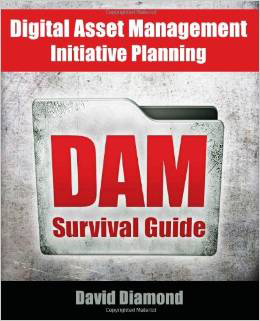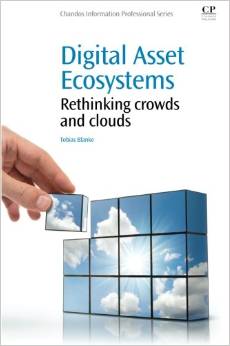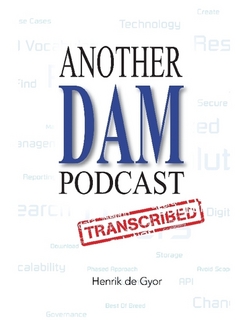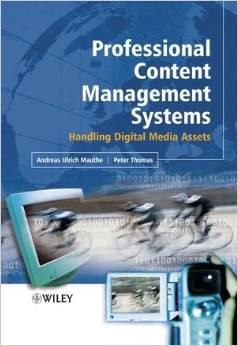The following DAM-related books are reviewed by DAM News editor, Ralph Windsor.
- DAM Survival Guide: Digital Asset Management Initiative Planning
- Metadata for Content Management: Designing taxonomy, metadata, policy and workflow to make digital content systems better for users
- Digital Asset Management: Content Architectures, Project Management, and Creating Order Out of Media Chaos
- Digital And Marketing Asset Management
- Digital Asset Management
- Digital Asset Ecosystems: Rethinking Crowds and Cloud
- Another DAM Podcast Transcribed
- Professional Content Management Systems: Handling Digital Media Assets
- Implementing a Digital Asset Management System: For Animation, Computer Games, and Web Development
DAM Survival Guide: Digital Asset Management Initiative Planning
David Diamond
David Diamond’s book was written in 2012 and was the first title to address the issue of how to establish and manage DAM initiatives. Many of the previously published reference works dealt with the topic from a technical or production oriented perspective and there was an obvious gap in the market which he was the first author to fill. A lot of information articles available on vendor or consultant blogs that were written since David’s book was published are clearly influenced by his work.
The DAM Survival Guide makes no assumptions about the reader’s prior knowledge and starts with some basic explanations of what the subject is all about. The opening chapter makes the comparison between Digital Asset Management and Physical Asset Management which frames the discussion in terms of logistics or supply chain management and is a good way to view the process of implementing and managing DAM initiatives.
The book contains numerous excellent points, not least of which is that the software is only one component of a DAM strategy and why you need to carefully define what you expect to get out of Digital Asset Management before you commence choosing products. Another is the distinction between content and files. David makes the observation that over a period of time as Cloud delivery methods become more prevalent, files will become less significant as containers for binary data and you will just send links instead.
Each of the major topics about DAM implementation is addressed: metadata (including taxonomies and controlled vocabularies), the key components of a DAM solution, DAM initiative team members, developing a plan, reviewing DAM solutions, working with consultants as well as the psychology of DAM users.
The DAM Survival Guide presents credible and real-world advice delivered by someone who has worked in the industry for over fifteen years. It is one of the two books about DAM that should be purchased by anyone who is already involved in Digital Asset Management or those who plan to become more acquainted with it.
A free 100 page excerpt of the book is available from David Diamond’s employer, DAM vendor, Picturepark: http://picturepark.com/digital-asset-management-white-papers/. There is also a blog with the same title also written by David: DAM Survival Guide
Metadata for Content Management: Designing taxonomy, metadata, policy and workflow to make digital content systems better for users
David Diamond
David Diamond, is the author of another DAM textbook, The DAM Survival Guide. The title for David’s most recent publication, Metadata For Content Management was chosen because David believes the subject has relevance to content-oriented solutions and strategies of all kinds, rather than just Digital Asset Management.
Although David works for a DAM vendor, his perspective is not technology-centric and it is clear that he has understood that for most end users, metadata that is critical to the implementation of a successful Digital Asset Management strategy because otherwise you lack a framework for your decision-making processes. Metadata is what transform the value of binary data into digital assets. If there isn’t any metadata, there is no digital asset and is the reason why people originally consider DAM.
The book goes into some depth on the whole metadata realisation process, including strategy, schema design and methods of implementing metadata models using a content system such as a DAM solution. Many of the typical challenges that those planning metadata strategies may come up against are covered, including the different sub-categories of metadata. Towards the end of the title, a section is included where David assesses how metadata trends may develop in the future and this covers aspects like linked data and semantic relationships between entities (as represented by concepts like the semantic web).
Metadata For Content Management explains the key concepts of taxonomy and metadata model design and those who have little background in these areas will find the book to be of particular benefit. David’s explanations of metadata and information architecture are some of the easiest to understand that I have read on the subject and make them accessible to a far wider audience than might have previously been the case.
Metadata For Content Management is one of the only books about DAM and content management technology which addresses the metadata element exclusively. While this is not the only subject that you need to think about to deliver Digital Asset Management initiatives, it certainly is the single most important one and as such, this book needs to be considered by anyone who has managerial responsibility for DAM in their organisation.
Digital Asset Management: Content Architectures, Project Management, and Creating Order Out of Media Chaos
Elizabeth Keathley
Elizabeth Keathley’s book was first published in March 2014, two years after DAM Survival Guide. A second edition came out in December 2015 with a preface by Henrik deGyor and also a chapter on risk management for DAM written by myself. A significant amount of the original text has been re-written along with updated diagrams and graphics.
This is the other major reference book about modern Digital Asset Management implementation. Elizabeth takes a more scholarly approach to the subject, but this is balanced with a lively style which keeps the reader engaged.
The background to DAM is covered, including explaining the origins, choosing solutions, staffing and then all of the major considerations like search, metadata, workflow design, hosting, migration as well as more technically sophisticated topics like image processing, databases, integration and advanced search/selection methods. Where the DAM Survival Guide is more like being introduced to the subject by an experienced professional insider, this book is closer to a structured training programme of the type you might get at a university or educational institution.
In addition to education and explanation, there is a fair amount of opinion in Elizabeth’s title and some is at a reasonably high academic level (for example, there are points that make reference to political ideologies). Since the delivery is very professionally handled, this serves more as introductions to the debating points rather than sermonising and provides a perspective to the topic of DAM than many readers might not have considered otherwise. I must emphasise that this book is not an academic thesis, it is packed full of detailed and practical advice which you can put to work right away, but it does serve to illustrate that Digital Asset Management has some wider implications than just filing corporate logos and marketing photos.
If you are debating which book to purchase, given the relatively low cost, getting both still seems good value. Although the subject is the same, the treatment is different and they both compliment each other well. In my opinion, you can learn the fundamentals of DAM from just the these two texts alone.
Disclaimer: I am a contributor to this book.
Digital and Marketing Asset Management
Theresa Regli
Theresa Regli’s book about DAM was published in August 2016 and covers many of the key topics enterprise DAM solution buyers are likely to be interested in. The title starts off with some key concepts and history about the origins of the DAM market, such as the different sectors where it developed in parallel (stock media, publishing and video). She describes the conceptual framework for an asset, noting that assets are composed of intrinsic value (which usually corresponds to a digital file) in combination with metadata.
There is a high level of technical detail about DAM contained within the text, including a good discussion explaining what ingestion is and in particular, the fact that both the essence (or file) and the metadata must be present at least in basic form before an asset exists. The information is both precise and in-depth. A number of conclusions are correct now, but might be on the verge of becoming out of date in the medium term. For example, there is a section about APIs which mentions that many vendors have implemented SOAP-based Web Services but that REST equivalents (which are more modern) tend not to be as prevalent. This is currently accurate, but it is a situation which is undergoing revision at present. If you are contemplating purchasing this book, ensure you get hold of a recent edition otherwise some sections may date quickly (this has been an issue with older DAM books in the past).
The latter chapters cover strategic considerations like support, vendor partnerships and placing DAM within the context of other frameworks (e.g. digital marketing). Theresa has addressed most of the implementation-oriented subjects that tend to occur in the course of most DAM implementation projects including how they interface with wider IT and systems considerations.
There are elements that are missing such as placing the subjects within the context of a business analysis or project management methodology. To be clear on the definitions, by ‘business analyst’ I do not mean industry analysis. I am referring to the IT sense of the term, someone who collects requirements and provides the interface between stakeholders and suppliers (which may include an IT department as well as a vendor). There are descriptions in the book which she states would be of interest for project managers, but these seem more like tactical implementation management. If you are a project manager who typically deals more with higher level subjects like risk management, quality management and budgets then these topics are more lightly covered.
The other aspect of this title which needs some work is the lack references and additional follow-up material written by other authors. A more comprehensive list of further reading materials should be provided where people can find out at least some of the inspiration/sources for the points made. Without the additional material, this can begin to come across a bit like a whitepaper rather than a learning resource.
Setting aside my recommendations for improvements, it is an excellent book which should be on any prospective reading list for those who need to learn more about Digital Asset Management.
Digital Asset Ecosystems: Rethinking Crowds and Cloud
Tobias Blanke
This is more of an academic-oriented title covering the context of modern Digital Asset Management. The book makes the point that DAM has changed relatively quickly in a short period of time so that the description ‘Digital Asset Ecosystems’ is now becoming a more accurate description of the goal of many implementations.
If you are looking for a ‘how to’ guide with advice about choosing systems and metadata etc then this may not be suitable. However, if you have a deeper interest in the context of DAM and where it connects with other related emerging technologies then it is more interesting and covers some subjects which Elizabeth Keathley’s book touches on but does not examine in as much detail. The author, Tobias Blanke is a lecturer and director of the MA in Digital Asset Management at King’s College London. I believe he also attends the London DAM Meetups for anyone who is looking to engage in a more in-depth discussion about the direction DAM is heading in.
Digital Asset Management
David Austerberry
This title was published in 2006 during the earlier stages of the recent upsurge in interest in DAM. The book is more oriented towards video and what some might describe as Media Asset Management (MAM) rather than DAM. There is a fair amount of technical detail, some of which still holds true (for example, the advantages of using a DAM system that has a Service Oriented Architecture) but much appears to be too low-level to be of use to managers, while simultaneously not in-depth enough for engineers. I can envisage this book appealing to IT managers based on a casual read-through, but they might find the information too out of date to assist with handling current implementation challenges and not so relevant as a result. There is also no mention of SaaS/hosted solutions and the list of products includes a number of vendors who have been acquired or no longer operate in DAM/MAM.
This book would benefit from an update. If it was revised with a fresh pair of eyes and in the context of the significant changes that have occurred since the last editions was published then it might become more useful again. Given the cost, I could not recommend it when compared with a few of the more modern alternatives described on this site.
Another DAM Podcast Transcribed
Henrik de Gyor
These are transcriptions of interviews conducted by the author, Henrik de Gyor. The electronic version might be useful for those who need to search the interview text. Copies of the audio podcasts and some of the transcripts are available on Henrik’s site: http://anotherdampodcast.com.
Professional Content Management Systems: Handling Digital Media Assets
Dr Andreas Mauthe, Dr Peter Thomas
This is another older title about DAM. It appears to be mostly a reference oriented text with details about video and media formats. The cost of the book is relatively expensive, possibly to reflect the specialist nature of the subject matter (although the used copies seem a little better value for money). I would recommend checking the contents and trying to read a few sample chapters before committing to a purchase.
Implementing a Digital Asset Management System: For Animation, Computer Games, and Web Development
Jens Jacobsen, Tilman Schlenker, Lisa Edwards
As the book title suggests, this is heavily oriented towards the Computer Games industry and is probably less about DAM and more how to structure production workflows. It was first published almost ten years ago and as with other books about DAM published at this time seems to be more production oriented (which would be consistent with the DAM solutions that were generally on offer at that time).










